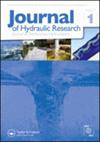无界均匀斜坡上恒定流入的重力流
IF 1.7
3区 工程技术
Q3 ENGINEERING, CIVIL
引用次数: 0
摘要
摘要在本研究中,我们进行了室内实验,研究在0°≤θ≤15°范围内,恒定流在无界均匀斜坡上传播所产生的重力流。在实验中,入口雷诺数和坡角是系统变化的。本研究进行了量纲分析,量化了五个无量纲参数,从而表征了重力流的发展。实验中所显示的俯视图显示,重力流在大于6°的陡坡上传播时呈细长形状,而在小于3°的平缓斜坡上传播时呈圆形。研究发现,当入口雷诺数足够大时,作为坡角函数的5个无量纲参数接近于恒定值,表明流动正在接近与雷诺数无关的状态。我们的实验结果有望适用于在更大尺度的自然或人为环境中由无界均匀斜坡上的恒定流入产生的重力流。关键词:恒流维数分析重力流倾斜底实验室实验许先生和y - a先生李老师请他帮忙做实验。披露声明作者未报告潜在的利益冲突。Notationbmax=重力流扩散的最大宽度(cm)b0=扩散器宽度(cm)h=最大水头高度(cm)h0=扩散器高度(cm)g=重力加速度(cms−2)g ' =减小重力(cms−2)Q0=体积流入率(cm3−1)Re=雷诺数(-)t=时间(s)uf=重力流的前缘速度(cms−1)Wp=浮力通量(cm4s−3)xf=前缘位置(cm)xf,v=虚原点与前缘之间的距离(cm)ν=流体的运动粘度(cm2s−1)π1=重力流的形状因子跨向(-)π2=重力流在墙法方向的形状因子(-)π3=与前位置和时间有关的无因次参数(-)π4=与最大宽度和时间有关的无因次参数(-)π5=与前位置有关的无因次参数(-)ρ0=周围流体密度(gcm−3)ρ1=流入重流体密度(gcm−3)θ=斜坡角(-)Δρ=流入重流体密度过剩(gcm−3)Δρf=头部流体密度过剩本研究由国立台湾大学资助,项目资助:106R7739, 106R7830, 107L7830, 107L7734, 112L7826,台湾国家科学技术委员会资助:107-2221-E-197-009, 108-2221-E-197-001-MY2, 111-2221-E-002-113-MY3。本文章由计算机程序翻译,如有差异,请以英文原文为准。
Gravity currents from a constant inflow on unbounded uniform slopes
AbstractIn this study we conducted laboratory experiments to examine the gravity currents produced from a constant inflow propagating on unbounded uniform slopes in the range 0∘≤θ≤15∘. In the experiments, the inlet Reynolds number and the slope angle were varied systematically. The study carried out dimensional analysis and quantified five dimensionless parameters, thereby characterizing the development of gravity currents. Top-view images shown in the experiments exhibited gravity currents in an elongated shape when propagating on steeper slopes larger than 6∘ but a round shape on milder slopes less than 3∘. The study finds that the five dimensionless parameters, which are functions of the slope angle, have near constant values for sufficiently large inlet Reynolds number, suggesting that the flow is approaching the regime of Reynolds number independence. The results from our experiments are expected to be applicable to gravity currents produced from a constant inflow on unbounded uniform slopes in larger scale natural or man-made environments.Keywords: Constant inflowdimensional analysisgravity currentsinclined bottomlaboratory experiments AcknowledgmentsThe authors would like to thank Mr L.-C. Hsu and Mr Y.-A. Li for help in running the experiments.Disclosure statementNo potential conflict of interest was reported by the author(s).Notationbmax=maximum width of spreading gravity currents (cm)b0=width of diffuser (cm)h=maximum head height (cm)h0=height of diffuser (cm)g=gravitational acceleration (cms−2)g′=reduced gravity (cms−2)Q0=volumetric inflow rate (cm3s−1)Re=Reynolds number (–)t=time (s)uf=front velocity of gravity currents (cms−1)Wp=buoyancy flux (cm4s−3)xf=front location (cm)xf,v=distance between the virtual origin and the front (cm)ν=kinematic viscosity of fluid (cm2s−1)π1=shape factor of the gravity currents in the spanwise direction (–)π2=shape factor of the gravity currents in the wall-normal direction (–)π3=dimensionless parameter relating front location and time (–)π4=dimensionless parameter relating maximum width and time (–)π5=dimensionless parameter relating the density difference in the head and front location (–)ρ0=density of ambient fluid (gcm−3)ρ1=density of inflow heavy fluid (gcm−3)θ=slope angle (–)Δρ=density excess of inflow heavy fluid (gcm−3)Δρf=density excess of the fluid in the head of the gravity currents (gcm−3)Additional informationFundingThe research was funded by National Taiwan University through grants 106R7739, 106R7830, 107L7830, 107L7734, 112L7826 and by Taiwan National Science and Technology Council through grants 107-2221-E-197-009, 108-2221-E-197-001-MY2, 111-2221-E-002-113-MY3.
求助全文
通过发布文献求助,成功后即可免费获取论文全文。
去求助
来源期刊

Journal of Hydraulic Research
工程技术-工程:土木
CiteScore
4.90
自引率
4.30%
发文量
55
审稿时长
6.6 months
期刊介绍:
The Journal of Hydraulic Research (JHR) is the flagship journal of the International Association for Hydro-Environment Engineering and Research (IAHR). It publishes research papers in theoretical, experimental and computational hydraulics and fluid mechanics, particularly relating to rivers, lakes, estuaries, coasts, constructed waterways, and some internal flows such as pipe flows. To reflect current tendencies in water research, outcomes of interdisciplinary hydro-environment studies with a strong fluid mechanical component are especially invited. Although the preference is given to the fundamental issues, the papers focusing on important unconventional or emerging applications of broad interest are also welcome.
 求助内容:
求助内容: 应助结果提醒方式:
应助结果提醒方式:


